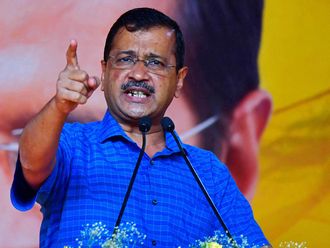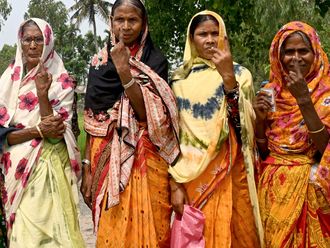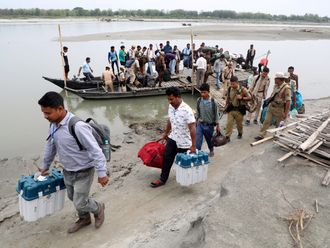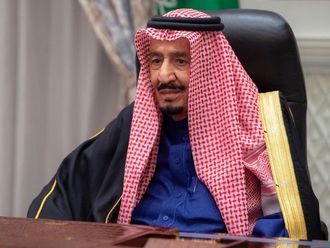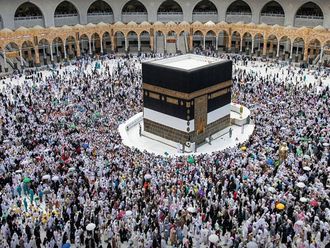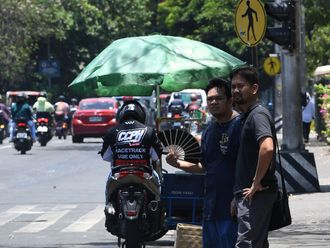Hyderabad: The Telangana and Seemandhra regions of Andhra Pradesh have emerged as two distinct battlegrounds in India’s elections.
The country’s Parliament passed a bill in February to divide Andhra Pradesh, the biggest state in southern India, into Telangana and the residual state of Andhra Pradesh — with the bifurcation itself the biggest issue on both sides.
The state, which has played a decisive role in bringing the Congress-led UPA government to power twice by giving Congress and its allies 37 seats (Congress, TRS, MIM) and Congress alone 33 seats, in 2004 and 2009 respectively, is likely produce some major upsets this time.
The near paralysis in the last five years, caused by the death of Chief Minister Y.S. Rajasekhar Reddy in an air crash, frequent changes in leadership, internal strife within the Congress — leading to large scale exodus of leaders, and strikes culminating in the division of the state have turned the party’s fortunes upside down.
While it was facing a complete decimation in the 13 districts of Seemandhra regions, the situation continues to be dicey for the party in Telangana despite it delivering a Telangana state.
In a state where it had swept the last two elections, it will be nothing less than a miracle if the Congress manages to touch double digits out of total 42 Lok Sabha seats and capture power in Telangana.
The party has blamed Telangana Rashtra Samiti (TRS) Chief K. Chandrasekhar Rao for its predicament.
“He promised to merge his party with Congress after bifurcation but went back [on his word]. What can we do?” said the Telangana State Congress President Ponnala Lakshmaiah.
Why did TRS betray the Congress?
Rao, also known as KCR, had his own plans which came a cropper.
Based on opinion polls projections of a Narendra Modi-led NDA government in New Delhi, KCR made overtures towards the BJP for an alliance. But the BJP preferred the Telugu Desam Party (TDP), hoping for a bigger windfall.
BJP strategists were hoping the party would win a handful of seats in Telangana on its own, while an alliance with TDP would benefit them in Seemandhra.
Telangana with 17 Lok Sabha and 119 assembly seats is witnessing a multi-cornered fight. While the TRS and the Congress are the two main contenders, the BJP-TDP alliance and smaller players like YSR Congress, Lok Satta, Aam Admi Party and the CPIM have also fielded a large number of candidates who can play the spoilsports.
Even the Majlis-e-Ittehad-ul Muslimeen (MIM), which is traditionally confined to the Muslim dominated old city, has entered the fray in many constituencies of Ranga Reddy, Nalgonda and Nizamabad districts.
The presence of so many candidates makes any prediction foolhardy.
The smaller parties can cut both ways. In 2009, the presence of two new smaller parties Praja Rajyam Party and Lok Satta deprived TDP of a certain victory.
However many opinion polls have projected a hung assembly in Telangana with the Congress and TRS sharing the spoils. Either the two parties will be forced to form a coalition government or one of them will try to form its own government with the support of smaller parties. CPI is the only pre-poll ally Congress could find.
The BJP’s hope of emerging as a leading political force has been dashed by several factors, especially its alliance with the TDP, imposed by party’s central leadership. The alliance has caused widespread discontent and rebellion within the party. Many BJP leaders were afraid that TDP’s anti Telangana image would harm their interest.
The TDP has left eight Lok Sabha and 45 Assembly seats. But the party could not find strong candidates in many Assembly constituencies. In the Bhupalapally Assembly constituency of Warangal, the BJP had to give a ticket to the TDP leader, as it did not have any willing candidate of its own.
While the BJP’s prospects were somewhat brighter in a couple of Lok Sabha constituencies in Telangana, the party was unlikely to reach the double digits in the state Assembly.
Meanwhile, in a clever move, the MIM has fielded candidates from the majority communities in three Lok Sabha constituencies of Secunderabad, Malkajgiri and Bhongir, raising fears in the Congress that the candidates will hurt its own prospects of attracting crucial Muslim votes.
The Congress was making behind-the-scenes efforts to persuade the MIM to withdraw its candidates.
In other constituencies the fear of the BJP and Narendra Modi was driving Muslim voters toward the Congress as they found KCR unreliable and were apprehensive that he would not hesitate to join hands with the BJP after elections.
The Lok Satta is also posing a threat to the TDP in Telangana constituencies with significant population of settlers or the people form Seemandhra region.
Originally the TDP wanted the Lok Satta to be part of a grand anti-Congress alliance but that did not work out. With a Lok Sabha President and IAS-turned-politician in the fray in Malkajgiri, the party has fielded 45 candidates in assembly elections.
Moreover, all the major parties were facing the problem of rebel candidates who were likely to hit the prospects of the official candidates.
As far as the Lok Sabha seats are concerned, media projections suggest that Congress along with CPI can win up to 10 of the 17 Lok Sabha seats and MIM will retain its Hyderabad seat. The remaining seven seats will be shared by the TRS and BJP.
The Seemandhra region, with 25 Lok Sabha and 175 assembly seats, was witnessing a direct fight between the TDP-BJP alliance and the YSR Congress party, though Congress still has a presence in some pockets.
The Lok Satta and Jai Samakiya Andhra party of former Chief Minister N. Kiran Kumar Reddy have also fielded candidates in the region.
The Congress was facing an unprecedented wave of anger as many blame the party for the bifurcation of the state, and taking away Hyderabad along with its job opportunities from them.
This was reflected in the large-scale defection of MPs, MLAs and other leaders to the YSRCP and the TDP.
Nearly 80 of the party’s MLAs and several MPs, including two union ministers D. Purandeswari and Kavuri Sambasiva Rao, have quit the Congress.
Purandeswari, the daughter of Telugu Desam founder NTR, has joined the BJP.
Some seniors like union ministers Pallam Raju and Panabaka Lakshmi were still holding the fort, but whether they will be able to retain their seats is a big question. Another union minster and film star Chiranjeevi was still in Congress and can mobilise his fans and the numerically strong Kapu caste.
TDP supremo N Chandrababu Naidu was confident that the alliance would bag a majority of 25 Lok Sabha seats and his party will form the next government in residuary state of Andhra Pradesh.
But YSRCP could be a big stumbling block in his path for several reasons.
The alliance with the BJP has generated a lot of resentment within the ranks of the TDP. Several top TDP leaders were apprehensive that the pro-Telangana image of BJP could be counter productive. Secondly, the BJP’s alliance could drive away the minority votes and consolidate them in favour of the YSRCP.


